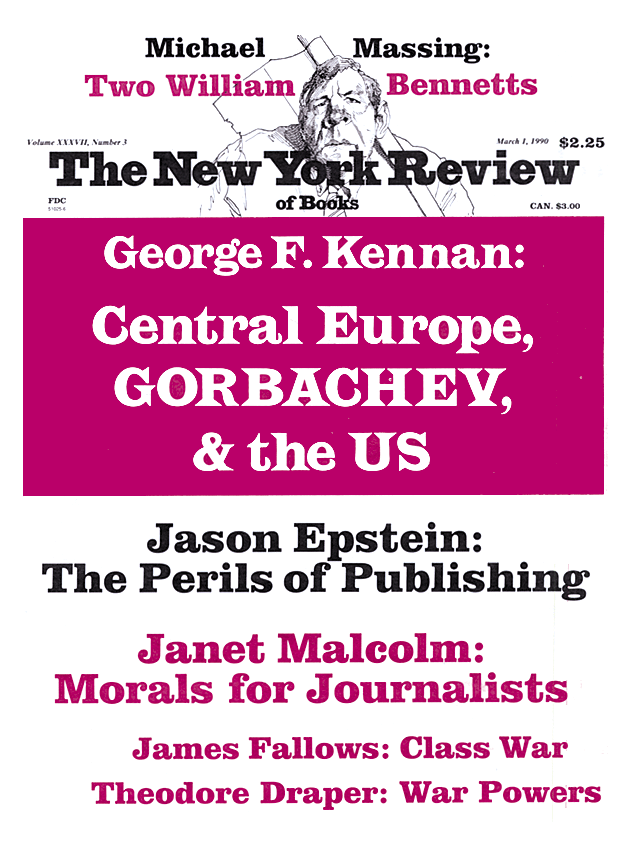In response to:
In Bed with Social Science from the October 12, 1989 issue
To the Editors:
In her essay “In Bed with Social Science” [NYR, October 12, 1989], Diane Johnson makes several incorrect references to Burning Desires: Sex in America, A Report from the Field, by David Talbot and myself.
For instance, Johnson writes that we contend “that though there may have been a moment in the Eighties when it [the sexual revolution] seemed over, now everything is back on the sexual fast track.” But Burning Desires hardly asserts that America is back on some fast track. What we actually wrote is this: “The sexual revolution was transformed by the 1980s, not terminated. True, the revolution lost its frenetic quality when confronted by the decade’s new viral threats and the strong cultural backlash launched by conservatives, radical feminists, and burned-out sexual liberationists. But the underlying currents of the sexual revolution continued to flow through American society.” And we go on to explain how women continued to dismantle the double standard, how sexual activity among teens remained high (even among conservative religious youths) and how gay culture was not destroyed, even in the face of the AIDS epidemic. At the end of the book we give evidence of a new sexual underground that would shock the Kinsey authors and seems to dismay the prissy Johnson.
Later, Johnson quotes us: “The AIDS terror was as much a cultural creation as a public health crisis, a punishment inflicted by the nation on itself to atone for its years of sexual celebration.” “This,” concludes Johnson, “seems an example of what the Kinsey editors think contributes to ‘pluralistic ignorance.’ ” But perhaps Johnson is a bit guilty of what might be called parochial ignorance. The context of our quote is a little more complicated. “If sexual play and experimentation were not killed off in the 1980s, they did become deeply entangled with morbid associations…. The AIDS virus did not penetrate deeply into the heterosexual population…. But the psychological impact of the disease was profound…. America has long been torn between its randy and repressive impulses….”
The problem with the new Kinsey Institute survey is that it was done in 1970, before gay liberation; before the full impact of the birth control pill, the “discovery” of the clitoral orgasm, and the sexual implications of early 1970s feminism; before the spread of what used to be called youth culture on the nation’s campuses, that one big bed feeling which so annoyed intellectuals of Diane Johnson’s age but forged the smiling memories of our thirty-something generation; before, certainly, the hedonistic excesses, so sweet yet ultimately dangerous, of the later 1970s and early 1980s. In short, the new Kinsey researchers took the measure of nothing and found nothing.
The problem with Johnson is different. She is like the parent in the living room who turns up Bach to drown out the sounds of the Beastie Boys blasting from the garage. But then after a glass of chardonnay, or two, she finds herself compelled to sneak to the half open door and watch as her daughter fondles the punk from downstairs. For years Johnson has made something of a career out of tuttutting the comings and goings of us Californians for timid readers in the East. Never missing a trick, of course. Hers is the sort of oh-no-yes-please brand of voyeurism that titillates without offending, like a Time magazine essay on pornography.
What we are in danger of losing in all this glib revisionism is that a generation of Americans, ignored by the new Kinsey researchers and twittered at by the Johnsons, had the time of their lives a few years back, and have now moved on with a good deal of joy—keeping the home fires burning—or with not a little bit of tragedy.
Steve Chapple
San Francisco, California
Diane Johnson replies:
I confess I was startled to figure as the personification of age, censoriousness, and parental disapproval in the imagination of a person of Mr. Chapple’s age, “thirty-something,” as he archly describes it. To set him straight on one point of social history, the intellectuals of my age, finding themselves that age in the 1970s, far from disapproving of the youth culture of the time, tried to turn back the clock and join in—a normal response to feeling a little bit over the hill, and one which Mr. Chapple’s wistful and nostalgic reference to “smiling memories” suggests he is beginning to understand.
I had mentioned Mr. Chapple’s book in a footnote to my review of the second Kinsey report, in order to acknowledge that there were authors who took issue with the Kinsey report’s conclusion that news of a “sexual revolution” had been exaggerated. I suspect that Mr. Chapple is peeved to be said to have contributed to “pluralistic ignorance,” the Kinsey report’s term for the idea people get, from reading about such things as Mr. Chapple’s “sexual underground,” that everyone else is having a more exotic sexual life than they are. As to whether there was or wasn’t a sexual revolution, it was not the question I was addressing or attempting to settle. But let me say here that since sexual undergrounds are by definition marginal, not general, Mr. Chapple’s book was not convincing.
This Issue
March 1, 1990


